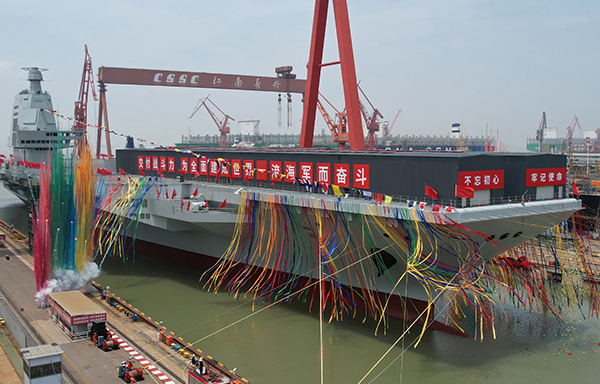China, on 17 June, launched its third aircraft carrier, the country’s most advanced, as an aggressive Beijing sought to extend the range of its navy in the strategic Indo-Pacific region and perhaps at a later date to the faraway Indian Ocean where it has already acquired bases.
The first domestically designed and built aircraft carrier named Fujian was launched at a brief ceremony held at Shanghai’s Jiangnan Shipyard. Fujian is the name of China’s eastern coastal province of Fujian.
The launch was delayed by two months due to the COVID lockdown of Shanghai. It was due to be launched on April 23 around the 73rd anniversary of the People’s Liberation Army Navy (PLAN).
The J-15 aircraft which China currently operates for its aircraft carriers were regarded a major problem for the PLAN as each plane weighed about 18 tonnes, too heavy for carriers in the long run. The planes were considered to be a big drag.
Catapult Details
The third aircraft carrier built by China State Shipbuilding Corporation Limited has a displacement of more than 80,000 tonnes and is equipped with electromagnetic catapults and arresting devices.
EMALS was regarded by Indian naval experts as a major leap forward by the Chinese navy as currently, only the US has such an advanced one.
It is more energy-efficient and reduces maintenance. It is also used on the US Navy’s Gerald R. Ford-class carriers.
China’s other two aircraft carriers, which are equipped with ski-jump take-off ramps, the Fujian features a flat-top flight deck.
The Type 003 warship with a hull number of 18 is the first carrier in China’s fleet to use an electromagnetic catapult to launch planes from the deck, which is faster than the older steam catapult system.
Future Plans
China’s first aircraft carrier, the Liaoning, was a refit of the Soviet-era ship commissioned in 2012, followed by the indigenously built 2nd aircraft carrier Shandong in 2019.
China plans to have around five aircraft carriers, according to the official media.
The next aircraft carrier China plans to build is expected to be nuclear-powered.
However, recent reports said the speedy launch of the aircraft carriers is resulting in technical issues and repairs delaying their operational readiness.
China’s indigenously built 2nd aircraft carrier Shandong, which was launched in 2019, had to undergo in April its first maintenance and comprehensive examination.
China’s first aircraft carrier, the Liaoning, a refit of the Soviet-era ship which was commissioned in 2012, is so far the only Chinese aircraft carrier with initial operational capability or the basic level of combat readiness.
Strategic Significance
However, the launch of Fujian was expected to provide more room for China to operate in the South China Sea and Taiwan Straits which have strategic significance for China where it is pitted against periodic US naval incursions, including the aircraft carriers.
Experts say the fast-paced construction of aircraft carriers by China has strategic significance for India too.
The launch of Fujian could provide leeway for PLAN to step out of the region and head to India’s backyard, the Indian Ocean, where the Indian Navy has a sizable presence. China has already expanded its naval base at Djibouti in the horn of Africa to berth aircraft carriers.
China has also acquired the Hambantota port in Sri Lanka as a debt swap for 99 years. It is also modernising Pakistan’s Gwadar port on the Arabian Sea.
Naval experts say Fujian may take some time for operationalisation. Perhaps PLAN may begin sending aircraft carriers to the Indian Ocean by 2025.
China’s naval buildup comes amid growing geopolitical tensions with the US, which under President Joe Biden is seeking to strengthen ties with allies and partners in the Asia-Pacific region to counter Beijing’s growing economic influence and military might.













